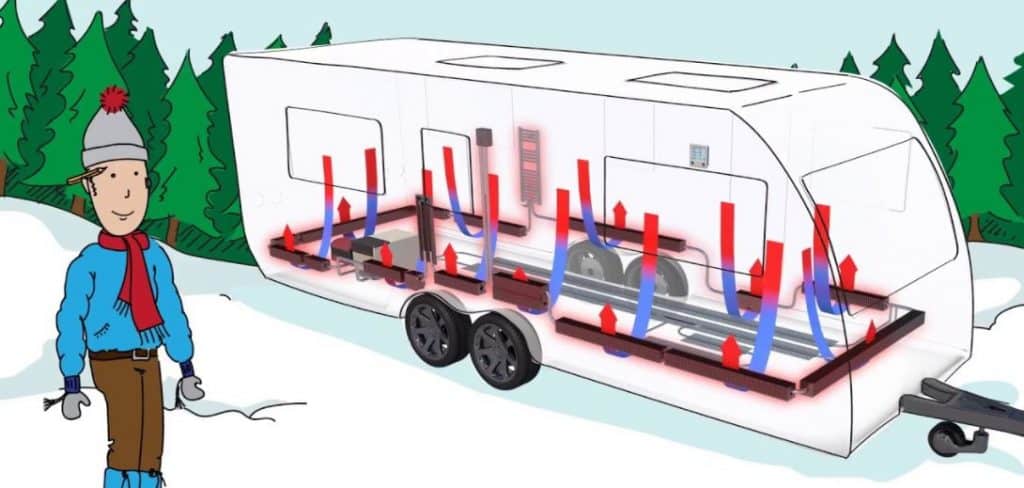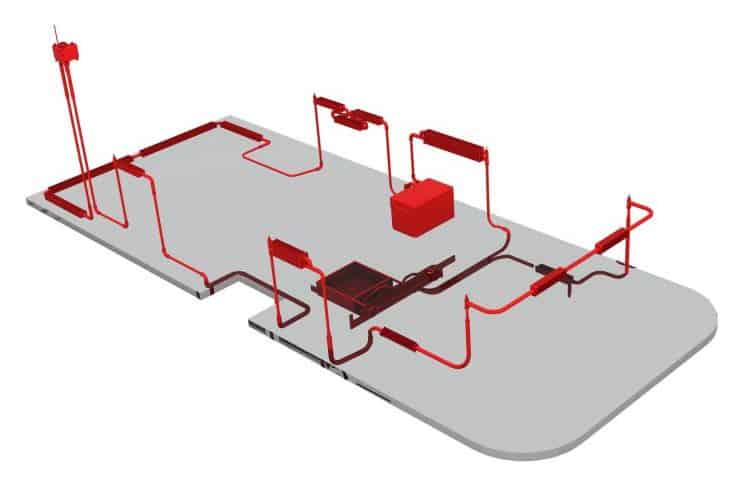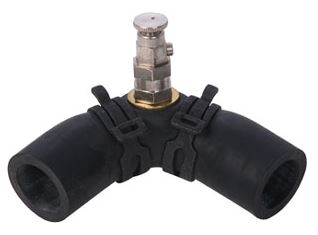
When we have guests on our site at the beginning and the end of the year, I have various conversations with them about how they are staying warm in their caravan or motorhome. Guests who have more ‘premium’ caravans and motorhomes often have Alde wet heating installed. So with today’s post, I thought I would write about some of the feedback they have provided to me on their impressions of the Alde wet heating system and its pros and cons. Therefore, when you are considering a new (or second-hand) caravan or motorhome, you can decide if the Alde heating system is going to be a suitable fit for you.

Some people reading this post are going to be familiar with the general concept of what the Alde heating system is and how it works.
Others, at this point, may have no idea what an Alde heating system is. Or how its different to the most common heating systems found in caravans and motorhomes.
As always with my posts, I’m trying to cater to both groups. Therefore, please use the Table of Content below.
If you already know how the Alde heating system works, you can jump to the other sections of the post. Enjoy 🙂
Disclaimer: Hey! By the way… any links on this page that lead to products on Amazon or Caravan Guard are affiliate links, and I earn a commission if you make a purchase, with no additional cost to you 🙂
- Dissolves waste and removes odours naturally and has delightful mild fragrance
Want To Visit Horton Common? – Book Here
Table of Contents
Introduction To Alde Wet Heating
Some people are not familiar with the Alde heating system and how it differs from what’s fitted to most caravans and motorhomes.
You should have noticed the keyword I’ve used a couple of times above, ‘wet’. In most caravans and motorhomes, the space heating is provided via a hot air furnace (typically made by Truma).
The Alde heating system is referred to as ‘hydronic’, which is a fancy word for wet. In other words, the Alde heating system is a replication of how most homes in the UK get their space and hot water heating.
Its typically a combi gas boiler, providing space heating via radiators (or underfloor heating) and hot water for taps/showers etc.
However, the Alde system is a little different, as it can also use mains hookup if available.
For a quick visual summary of the Alde wet heating system fitted in caravans and motorhomes, please watch the video below:
Now there is something important to note. Caravans and motorhomes will be fitted with the same Alde combi boiler (3010 on older units, 3020 on newer units).
However, the number of radiators and their placement is unique to each unit. For instance, some will have towel rail heaters, while others won’t.
The point is some caravan manufacturers will do a better job than others at locating the radiators and pipework in easy-to-access locations.
Easy of access is important for maintenance etc. I’ll discuss that more later in the post. Now I’m going to discuss the pros and cons of the Alde heating system.
Alde Heating System Pros
To discuss the benefits (pros) of the Alde heating system, it will be in comparison to a standard hot blown air system. There is a range of benefits which include the following:
Better Heat Distribution
With a typical hot air furnace fitted in a caravan or motorhome, there can be areas that are colder than others.
For instance, a rear bathroom on a caravan or motorhome with hot air heating can notoriously be an issue. The are a couple of reasons for this.
The first is because the bathroom is the furthest point from the furnace.
The hot air will come out of the vents with the least resistance. Hence the vents that are closest to the hot air furnace in the kitchen and seating area.
It is possible to get vents with adjustable valves to direct more of the heat to the rear bathroom. However, there is a second issue.
Typically the hot air pipe to the bathroom goes under the caravan. Therefore, most of that heat is lost through the wall of the pipe before it reaches the bathroom.

The Alde heating system uses a liquid to transfer heat. Furthermore, the pipes do not go outside of the interior envelope.
Hence, heat is not lost unnecessarily. Leading to a more efficient system using less electricity/gas typically.
It also provides the caravan/motorhome manufacturer with more options on how to heat the space. With either radiators, underfloor heating pipes or even towel rail heaters.
With an Alde heating system, there are fewer chances of ‘cold spots’ within the caravan or motorhome.
Improved Efficiency
Several of our guests have changed their caravans and motorhomes over the years. Some of these have moved from Truma hot air heating to the Alde wet heating system.
They have commented that they believe their Alde heating system to be more efficient. When they needed to use gas as the heating fuel source, they were under the impression they were using less.
Now, this does make sense with regards to my comments above with hot air systems running pipes under the caravan etc.
However, other than Alde claiming a boiler efficiency rating of 93%, I don’t have any actual ‘evidence’ to back up that feedback.
What I will say however is when it comes to motorhomes, the Alde system definitely has the ‘ability’ to be more efficient. That’s because an optional engine heat exchanger can be fitted:
As yet, I’ve not had any feedback from a guest who have had the Alde engine heat exchanger fitted to their motorhome.
However, the concept of collecting some of the huge amounts of wasted heat an engine generates definitely makes sense.
Cost-wise I’m not sure how much it would be to have the optional Alde heat exchanger fitted.
The heat exchange itself appears to be around £200. So it really depends on how many hours it would take for the service centre engineer to fit it.
Better For Allergy Suffers (Dust)
As a hay fever sufferer myself, I know how much of a pain an allergic reaction can be.
Well, if you have a hot blown air system in a caravan or motorhome, that means dust is being lifted off surfaces and lifted into the air.
Therefore, anyone who has an air-born allergy such as a dust allergy, a hot air heating system in their caravan or motorhome could make their allergy symptoms worse.
While the Alde heating system will move the air around the caravan/motorhome due to the principle of hot air convection, it will not agitate the air (or dust) to the same degree.
However, whichever heating system you have, with allergies, you’re going to need a decent caravan vacuum cleaner.
Alde Heating System Cons
Pretty much every product or service has both pros and cons. And the Alde heating system is no different. First, let’s discuss the cost.
I don’t have direct cost comparison figures between the Truma hot air and Alde heating systems (yet).
However, as referenced above, its only usually found on ‘premium’ caravans and motorhomes. Hence, you have to pay a premium to have it.
Furthermore, as the system is more complicated than a hot air system, you should expect engineer visits to cost more.
With the system being more complicated, I wanted to discuss some of those associated disadvantages (cons).
Remembering To Change The Glycol
The Alde heating system is referred to as a ‘wet’ system. However, please don’t be under the impression the working fluid within the system is just water, its not.
If you just used water in the system, two things could happen. Internal corrosion damage could eventually permanently damage the Alde system.
Or in freezing temperatures, pure water would expand and break the Alde heating system. The actual working fluid is 60% water and 40% ethylene glycol (antifreeze).
Over time the anticorrosive properties of glycol break down and become less effective, therefore, it needs to be changed. The glycol needs to be changed every 2 or 5 years, depending on the antifreeze used.
Now, it would be great to say that any antifreeze glycol will be suitable for your Alde heating system. But that’s not the case.
Furthermore, the type of antifreeze glycol used in Alde heating systems has changed over the years. As standard, the Alde 3010 came with an antifreeze rated with a two years replacement schedule.
The Alde 3020 came with antifreeze rated for a 5-year replacement. The different types of antifreeze are in different colours. Some you can mix, some you can’t, it can be a bit of a minefield.

The Alde G13 Antifreeze is backwards compatible with the older 2-year antifreeze. G13 provides a 5-year working life: Image – Amazon.co.uk
The general point is, remembering to change the antifreeze in an Alde heating system is something you wouldn’t have to do with a hot air heating system.
Now, depending on what annual caravan servicing package you use, your service centre may keep an eye on the antifreeze for you. But don’t just presume they will.
Tapped Air In The Alde Heating System
For a fluid-based heating system to operate properly, the fluid has to be able to circulate around the system unobstructed.
However, anyone with radiators at home can appreciate the issue of air trapped in the system. Air can reduce or even stop the flow of heating fluid.
Well, the Alde heating system is also not immune to this issue. From time to time, the radiators need to be bled to release the air.
This will typically be required after you have swapped the glycol antifreeze in the system.

Eventually, air bubbles will work themselves to the highest point in the system. Depending on how well the system was designed, getting that air out of the system will be easier in some cases than in others.
For instance, has a connector with an air valve been fitted at the highest point?
Even more importantly, can you actually easily access that air valve? There are scenarios where users have reported the Alde system starting and then stopping within just a few minutes.
In some cases, this is an example of an issue created by an air pocket stopping the heating liquid.
The Alde boiler gets up to temp quickly (because no liquid is circulating), hits its temperature setting and stops.
Therefore, with an Alde heating system, you’re going to have to be prepared to bleed air from the system.
Leaks Are Not Impossible
So I just want to emphasise the point that none of our guests has ever told me that they have experienced leaks with their Alde heating system.
However, if you browse some of the forums online, you will find that it has happened to some people. There could be various reasons for leaks.
It may not be due to the Alde system itself, it could be down to poor workmanship fitting/maintaining the system.
However, the point remains its a potential problem that could present itself, which is not applicable to a hot air heating system for your caravan or motorhome.
Something else to remember, while you want to experience the same ‘home comforts’ in your caravan or motor home, they are different spaces.
What I mean by that is your home’s central heating system isn’t exposed to potholes is it?
I do wonder if many of the issues with leaks people have experienced with the Alde heating system could have started after they hit a particularly big pothole.
Alternatively, the leak could be due to the repeated effects of smaller bumps in the road.
I think we can all agree the pothole situation is not going to get any better within the next coming years, it may even get worse.
I don’t want that to put you off an Alde heating system, just bear in mind that leaks can happen. Therefore, proper inspection/maintenance of the Alde system is crucial.
Complicated Controls (Older Models)
Now this problem isn’t applicable to newer Alde heating systems with the coloured touch control panel. Its applicable to the older monochrome control panels.
A couple of years back, I remember I had a guest who had purchased a used caravan that came with the monochrome control panel.
It was a warm day, and they just wanted hot water for the taps and shower. However, they were having real trouble working with the control to get just hot water and not space heating.
I had a look at the Alde control panel, and even I couldn’t work it out, and I generally regard myself as pretty good with electronic controls.
After they spent some time browsing online for a user manual, they were able to figure it out. The point is though, the older Alde control panels are not exactly intuitive.
The more modern colour panels are much better and easier to operate.
You can also get smartphone apps that work with some Alde heating setups. In summary, the Alde heating controls can either be a pro or a con depending on the control panel fitted.
More on this topic in my hot water systems post.
Alde Heating Energy Sources
Before I wrap up this post I just want to reference the sources of energy for the Alde heating system. You can obviously run the boiler from your LPG gas bottle.
But you can also run from a mains hook-up. However, when it comes to the mains hooks up, you need to be aware of how much power is available to you.
Our fully serviced pitches provide 16A of power, which can run the Alde heating system on its maxium 3kW setting.
However, if you are on another site that has only a 6A supply, you would have to use the 1kW setting. If there is 10A available, you could choose the 2kW setting.
When it comes to running the Alde heating system from your LPG gas bottle, how much gas you use is obviously dependent on how cold it is and the load on the system.
Apparently, if the Alde combi boiler is running flat out, it will consume 405g of gas per hour. Therefore after 14 hours of flat out use, a typical 6kg Calor gas bottle would be empty.
That would seem alarming at first, but unless you are in the arctic circle, you’re not going to have the boiler running at full power constantly.
But what I would say is if you like to go wild/off-grid camping in the winter months, a refillable gas bottle may be a wise investment.
While your leisure battery cannot be used to power the boiler itself, the circulation pump is 12V. Hence, the Alde heating system will pull power from the leisure battery.
Conclusions On Alde Heating Systems For Caravans & Motorhomes
As you can see from the information above, the Alde wet heating system has a wide range of pros and cons.
While it has the benefits of better heat distribution and potential efficiency savings, it has the potential downsides of leaks and air blockages.
Generally, for larger caravans, I think the Alde heating system is more appropriate. But for smaller caravans, I think Truma hot air heating is sufficient.
Truma has been improving its heating systems as well over recent years, and I’ll write a post about Truma hot air heating at some point.
I do have a post on Alde vs Truma, which you may be interested to read. I’ve also got a general post on caravan heating systems.
Anyway, I hope you found this post useful to decide if you want to go for Alde wet heating on your next caravan or motorhome.
I also hope you consider coming to visit us here at Horton Common in the near future. 🙂
Want To Visit Horton Common? – Book Here

